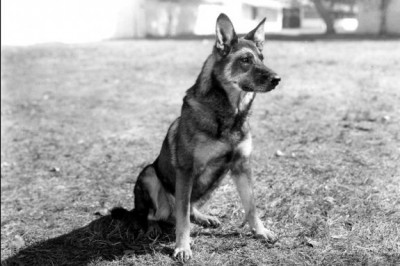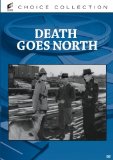| Reviews & Columns |
|
Reviews DVD TV on DVD Blu-ray 4K UHD International DVDs In Theaters Reviews by Studio Video Games Features Collector Series DVDs Easter Egg Database Interviews DVD Talk Radio Feature Articles Columns Anime Talk DVD Savant Horror DVDs The M.O.D. Squad Art House HD Talk Silent DVD
|
DVD Talk Forum |
|
|
| Resources |
|
DVD Price Search Customer Service #'s RCE Info Links |
|
Columns
|
|
|
Death Goes North
The movie is routine, but an interesting relic. It starts out as a Northwestern, set as it is in British Columbia, but near the end resembles a Charlie Chan-type murder mystery with an unexpected plot twist that the IMDb regrettably gives away, so don't look this one up if you want to be surprised.
Independently produced for release by Columbia, Death Goes North gets a good full-frame transfer but has no extras.
Timber thieves Albert and Bart Norton (Walter Byron and Arthur Kerr) and their henchmen have been blatantly cutting down trees and stealing lumber on Barlow land. Elsie Barlow (Sheila Bromley), who has been managing the lumbering operation since the death of her parents, anxiously awaits the arrival of her Uncle Herbert, co-owner of the land, a man she's never met.
An older man (Harry Hay) in possession of Elsie's cable turns up dead, murdered, at a local hotel, and everyone assumes he's Elsie's uncle. Royal Canadian Mounted Police Sergeant Ken Strange (Edgar Edwards) begins an inquest, while another Mountie, Dan MacKenzie, takes charge of King (Rin Tin Tin, Jr.), the dead man's German shepherd.
Suspicion immediately falls upon the Nortons, but there's also crazy if seemingly harmless old coot Freddy (Reginald Hincks); Gordon Hayes (actor not credited), a lumber company representative; and even family friend Puffy (James McGrath), the Barlow family's manservant.
But then Uncle Herbert Barlow (Jameson Thomas) suddenly appears, identifying the dead man as Robert Druid, the personal secretary he'd sent on ahead when Barlow's wife, Martha (Dorothy Bradshaw), fell ill in Vancouver. Barlow suspects the murderer mistook Druid for himself, and later on Barlow is shot in the arm in another murder attempt.
A company called Central Films produced Death Goes North, one of a dozen low-budget U.S.-Canadian productions released through Columbia between 1936-39. Death Goes North the last of the dozen, was released in July 1939, but all twelve were in the can by December 1937.
How these films came about is unknown to this reviewer, but likely explanations include the low cost of shooting in Canada and/or tax and quota laws similar to what led to American actors appearing in British films and primarily American productions being shot in England. It appears Central Films was a Canadian company at least partly owned by Columbia, but they may have merely provided product for Columbia's distribution arm.
The main cast consists of American and British actors who worked primarily in Hollywood, not Canada. Shelia Bromley later had a long career on American television as a character actress, one stretching into the mid-1970s. London-born Edgar Edwards typically played uncredited bit parts in bigger films, and henchman-type roles in B-movies and serials. After this he had larger roles in Flash Gordon Conquers the Universe and One Million B.C. (both 1940), then quickly faded back into obscurity.
Busy British character actor Jameson Thomas was dead by the time Death Goes North was released, the actor having died of tuberculosis in January 1939. Even here, 13 months earlier, he looks notably unsteady on his feet.
Rinty doesn't do anything particularly noteworthy. One audacious bit where he briefly pretends to have been shot dead only to leap back into action moments later gets an assist from the optical printer. The British Columbia locations are interesting, as is the logging footage, and the film doesn't appear any cheaper or less professional than other second features of its type.
Video & Audio
Death Goes North, filmed in 1.37:1 full frame and black-and-white, looks quite nice. Not extraordinary, but good for such an obscurity. The audio, English only with no other choices and no subtitle options, is likewise strong. There are no menu screens; the movie simply begins then restarts automatically after it's done. The disc is region-free. No Extra Features.
Parting Thoughts
It's hard to image a large audience clamoring to see a movie as minor and obscure as Death Goes North, but for those (like me) intrigued by these offbeat little movies, it's worth a look and therefore Recommended.
Stuart Galbraith IV is a Kyoto-based film historian whose work includes film history books, DVD and Blu-ray audio commentaries and special features. Visit Stuart's Cine Blogarama here.
|
| Popular Reviews |
| Sponsored Links |
|
|
| Sponsored Links |
|
|
| Release List | Reviews | Shop | Newsletter | Forum | DVD Giveaways | Blu-Ray | Advertise |
|
Copyright 2024 DVDTalk.com All Rights Reserved. Legal Info, Privacy Policy, Terms of Use,
Manage Preferences,
Your Privacy Choices | |||||||
















